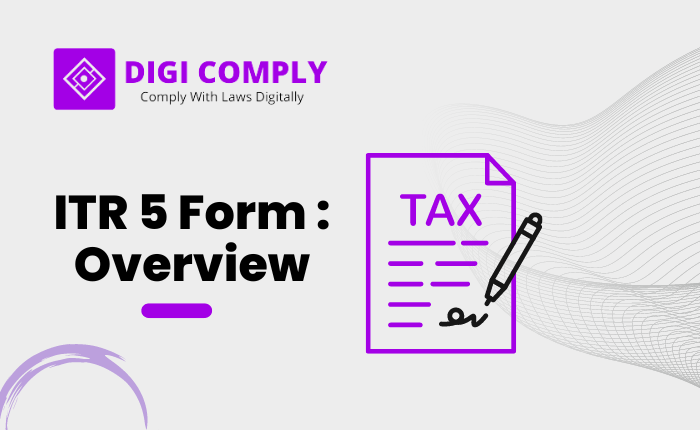Filing income tax returns (ITRs) is an essential part of every responsible citizen’s financial obligations. In India, there are various types of ITR forms available to cater to the diverse needs of different taxpayers. Among these, the ITR-5 form holds significant relevance for specific entities and individuals. In this blog, we will delve into the intricacies of the ITR-5 form, its purpose, eligibility criteria, and the essential information required for filing.
What is the ITR-5 Form?
The ITR-5 form is an income tax return form prescribed by the Income Tax Department of India. It is primarily designed for firms, Limited Liability Partnerships (LLPs), Association of Persons (AOPs), and Body of Individuals (BOIs). This form enables such entities to report their income, expenses, deductions, and tax liability to the authorities accurately.
Who is eligible for ITR-5:
The ITR-5 form is specifically designed for certain entities and individuals who are eligible to file their income tax returns using this form. The following are the eligible entities for ITR-5:
1. Firms: Partnership firms, including Limited Liability Partnerships (LLPs), can file their income tax returns using the ITR-5 form.
2. Association of Persons (AOPs): An Association of Persons (AOP), which refers to an association formed for a collective purpose that generates income, can use the ITR-5 form for filing their returns.
3. Body of Individuals (BOIs): Similar to AOPs, Body of Individuals (BOIs) can also utilize the ITR-5 form to report their income, deductions, and tax liability.
It’s important to note that individual taxpayers, Hindu Undivided Families (HUFs), and companies are not eligible to use the ITR-5 form. They have separate ITR forms designed specifically for their respective categories.
If you fall under any of the eligible entities mentioned above, you can use the ITR-5 form to fulfill your income tax filing obligations.
The ITR-5 Form, used for filing income tax returns in India, has a structured format consisting of two parts and several schedules. Each section serves a specific purpose to ensure accurate reporting of income, deductions, and tax liability. Here is a comprehensive description of the structure of the ITR-5 Form:
Part A: General Information
This section collects general details about the taxpayer, including personal information such as name, address, contact information, and PAN (Permanent Account Number). It also includes specific schedules such as:
– Part A-BS: Balance Sheet as on the last day of the Previous Financial Year
– Part A-Manufacturing Account for the previous financial year
– Part A-Trading Account for the previous financial year
– Part A-P and L: Profit and Loss Account for the previous financial year
– Part A-OI: Other information
– Part A-QD: Quantitative details
Part B: Computation of Total Income and Tax Liability
This part focuses on the computation of total income and tax liability. It consists of various schedules, each dedicated to specific aspects of income and deductions. The schedules include:
– Schedule-HP: Computation of income from House Property
– Schedule-BP: Computation of income from “profit and gains from business or profession”
– Schedule-DPM: Computation of depreciation on plant and machinery
– Schedule-DOA: Computation of depreciation on other assets
– Schedule-DEP: Summary of depreciation on all assets
– Schedule-DCG: Computation of deemed capital gains on the sale of depreciable assets
– Schedule-ESR: Deduction under section 35 (expenditure on scientific research)
– Schedule-CG: Computation of income from Capital Gains
– Schedule-OS: Computation of income from Other Sources
– Schedule-CYLA: Statement of income after set-off of current year’s losses
– Schedule-BFLA: Statement of income after set-off of unabsorbed loss brought forward from earlier years
– Schedule-CFL: Statement of losses to be carried forward to future years
– Schedule-UD: Unabsorbed Depreciation
– Schedule-ICDS: Effect of income computation disclosure standards on profit
– Schedule-10AA: Computation of deduction under section 10AA
– Schedule-80G: Details of donation entitled for deduction under section 80G
– Schedule-80GGA: Details of donation for scientific research or rural development
– Schedule-RA: Details of donations to research associations, etc.
– Schedule-80IA: Computation of deduction under section 80IA
– Schedule-80IB: Computation of deduction under section 80IB
– Schedule-80IC/80-IE: Computation of deduction under section 80IC/80-IE
– Schedule-80P: Deductions under section 80P
– Schedule-VIA: Statement of deductions under Chapter VIA
– Schedule-AMT: Computation of Alternate Minimum Tax payable
– Schedule-AMTC: Computation of tax credit under section 115JD
– Schedule-SI: Statement of income chargeable at special rates
– Schedule-IF: Information regarding partnership firms
– Schedule-EI: Statement of income not included in total income (exempt incomes)
– Schedule-PTI: Pass-Through Income details from business trust or investment fund
– Schedule-TPSA: Secondary adjustment to transfer price
– Schedule-FSI: Details of income from outside India and tax relief
– Schedule-TR: Summary of tax relief claimed for taxes paid outside India
– Schedule-FA: Details of foreign assets and income from outside India
– Schedule-GST: Information regarding turnover/gross receipt reported for GST
Part B – TI: Computation of Total Income
In this part, the taxpayer consolidates the calculations from the schedules to arrive at the total income.
Part B – TTI: Computation of Tax Liability on Total Income
This section focuses on the computation of tax liability based on the total income calculated in the previous section.
Tax Payments:
This section requires the taxpayer to provide details of tax payments made, including advance tax and self-assessment tax. It also includes information about tax deducted at source (TDS) on income other than salary and tax collected at source (TCS).
Verification:
At the end of the form, the authorized signatory of the taxpayer declares and verifies the information provided in the ITR-5 Form.
The Income Tax Department recommends following a specific sequence while filling out the form, starting with Part A, then the schedules, followed by Part B, and finally, the verification section.
By adhering to the structure and filling out the necessary details accurately, taxpayers can ensure compliance with tax regulations and facilitate the accurate assessment of their income and tax liability.
The ITR-5 Form is not applicable for the following categories of taxpayers:
– Individual taxpayers
– Hindu Undivided Families (HUFs)
– Companies
– Taxpayers who are required to file tax returns using Form ITR-7 under Sections 139(4A), 139(4B), 139(4C), 139(4D), 139(4E), or 139(4F) of the Income Tax Act.
Please note that these taxpayers should select the appropriate ITR form based on their category and specific requirements.
If You have any queries then connect with us at support@legalsuvidha.com or info@digicomply.in & contact us & stay updated with our latest blogs & articles





